Showing all 7 results
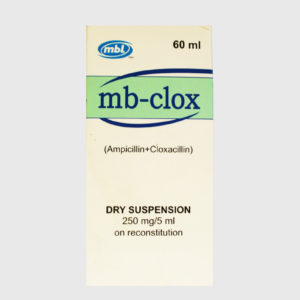
Each 5ml after reconstitution:
Ampicillin as Trihydrate BP125mg + Cloxacillin as Sodium BP 125mg
Mb-Clox Dry Suspension is effective in the treatment of respiratory tract infections, Ear, Nose and throat infections. Urinary tract infections, Gastro- intestinal infections, skin and soft tissue infections. Pelvic infections, Septicaemia, Endocarditis, Orthopaedic infections.
The use of this antibiotic may lead to the appearance of resistant strains of organisms and sensitivity resting should, therefore, be carried out wherever possible, to ensure the appropriateness of the therapy. Infections caused by susceptible organisms where a mixed infection is present and includes penicillin-resistant staphylococci.
500 mg –1 g (1 –2 x 500 mg capsules) every 6 hours.
Children 2 –10 years : 250 –500 mg (5 –10 mL of 250 mg/5 mL syrup) every 6 hours.
Children up to 2 years : 250 mg (5 mL of 250 mg/5 mL syrup) every 6 hours.
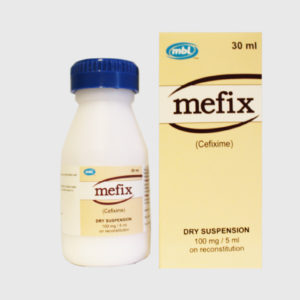
Each 5ml Contains after reconstitution:
Cefixime as Trihydrate U.S.P…………… 100 mg
Cefixime is an orally active Cephalosporin antibiotic, which has marked in vitro bactericidal activity against wide range of Gram positive and Gram negative organisms. It is indicated for the treatment of the acute infection caused by susceptible micro organisms. Upper respiratory tract infection (URTI), Otitis media, Sinusitis, Pharyngitis, Tonsillitis, Lower Respiratory tract infection (LRTI) Bronchitis, Urinary tract infection (UTI), Cystitis, Cystourethritis, Uncomplicated pyelonephritis and uncomplicated gonorrhea (Cervical/Urethral, rectal and pharyngeal).
Once Cefixime is reconstituted, the recommended dose of the suspension is 400 mg daily. For the treatment of uncomplicated cervical/urethral gonococcal infections, a single oral dose of 400 mg is recommended.
The recommended dose is 8 mg/kg/day of the suspension. This may be administered as a single daily dose or may be given in two divided doses, as 4 mg/kg every 12 hours.
PEDIATRIC DOSAGE CHART
Patient Weight (Kg) Dose/Day (mg) Dose/Day (ml) Dose/Day tsp of suspension
6.25 50 2.5 ½
12.5 100 5 1
18.75 150 7.5 1 ½
25 200 10 2
31.25 250 12.5 2 ½
37.5 300 15 3
Children weighing more than 50 kg or older than 12 years should be treated with the recommended adult dose.
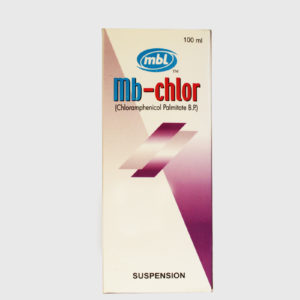
Each 5ml contains:
ChloramphenicolPalmitate
Eq. to Chloramphenicol BP 125mg
It is effective against typhoid and broad –spectrum bacterial (Gram-positive and Gram-negative) diseases. Chloramphenicol Palmitate is a dichloroacetic acid derivative. Chloramphenicol is a broad-spectrum antibiotic and is bacteriostatic. Chloramphenicol is hydrolysed in the upper intestinal tract into the parent drug. It is lipid soluble, diffuses through the bacterial cell membrane and reversibly binds to the 50 S subunit of bacterial ribosomes where transfer of amino acids to growing peptide chains is prevented, thus inhibiting peptide bond formation and subsequent protein synthesis.
• For oral dosage forms (capsules and suspension):
o Adults and teenagers—Dose is based on body weight. The usual dose is 12.5 milligrams (mg) per kilogram (kg) (5.7 mg per pound) of body weight every six hours.
o Children— Infants up to 2 weeks of age: Dose is based on body weight. The usual dose is 6.25 mg per kg (2.8 mg per pound) of body weight every six hours. Infants 2 weeks of age and older: Dose is based on body weight. The usual dose is 12.5 mg per kg (5.7 mg per pound) of body weight every six hours; or 25 mg per kg (11.4 mg per pound) of body weight every twelve hours.
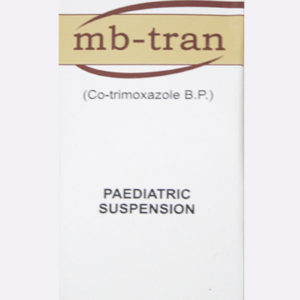
Trimethoprim BP 40mg + Sulphamethoxazole BP 200mg
Co-Trimoxazole Suspension is indicated for the treatment of the following infections when owing to sensitive organisms. Treatment and prevention of Pneumocystis jiroveci (P. carinii) pneumonitis
Treatment and prophylaxis of toxoplasmosis.Treatment of nocardiosis
The following infections may be treated with Co-Trimoxazole Suspension where there is bacterial evidence of sensitivity to Co-Trimoxazole Suspension and good reason to prefer the combination of antibiotics in Co-Trimoxazole Suspension to a single antibiotic: Acute uncomplicated urinary tract infection.Acute otitis media. Acute exacerbation of chronic bronchitis.Consideration should be given to official guidance on the appropriate use of antibacterial agents.
Method of administration: oral.
It may be preferable to take Co-Trimoxazole Suspension with some food or drink
to minimize the possibility of gastrointestinal disturbances.
Standard dosage recommendations for acute infections
STANDARD DOSAGE
Age Paediatric Suspension
6 to 12 years 10 ml every 12 hours
6 months to 5 years 5 ml every 12 hours
6 weeks to 5 months 2.5 ml every 12 hours
Or as directed by the physician.

Trimethoprim BP 40mg + Sulphamethoxazole BP 200mg
Co-Trimoxazole Suspension is indicated for the treatment of the following infections when owing to sensitive organisms. Treatment and prevention of Pneumocystis jiroveci (P. carinii) pneumonitis
Treatment and prophylaxis of toxoplasmosis.Treatment of nocardiosis
The following infections may be treated with Co-Trimoxazole Suspension where there is bacterial evidence of sensitivity to Co-Trimoxazole Suspension and good reason to prefer the combination of antibiotics in Co-Trimoxazole Suspension to a single antibiotic: Acute uncomplicated urinary tract infection.Acute otitis media. Acute exacerbation of chronic bronchitis.Consideration should be given to official guidance on the appropriate use of antibacterial agents.
Method of administration: oral.
It may be preferable to take Co-Trimoxazole Suspension with some food or drink
to minimize the possibility of gastrointestinal disturbances.
Standard dosage recommendations for acute infections
Children aged 12 years and under:
STANDARD DOSAGE
Age Paediatric Suspension
6 to 12 years 10 ml every 12 hours
6 months to 5 years 5 ml every 12 hours
6 weeks to 5 months 2.5 ml every 12 hours
Or as directed by the physician.
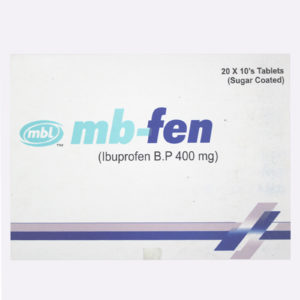
Each 5ml
Contains:
Ibuprofen Suspension B.P.100mg
Rheumatic Diseases such as:
Rheumatoid arthritis, Osteoarthritis, Ankylosing Spondylitis, Juvenile rheumatoid arthritis. Pain and inflammation following dental or obstetric surgery, acute gouty arthritis, Painful non-rheumatic inflammatory conditions such as athletic injuries strains or sprains), Bursitis, capsulitis, synovitis, Tendinitis or tenosynovitis. For reduction of fever. For the relief of pain associated with the primary dysmenorrheoa.
PEDIATRIC PATIENTS
Fever Reduction:
For reduction of fever in children, 6 months up to 2 years of age, the dosage should be adjusted on the basis of the initial temperature level. The recommended dose is 5 mg/kg if the baseline temperature is less than 102.5°F, or 10 mg/kg if the baseline temperature is 102.5°F or greater. The duration of fever reduction is generally 6 to 8 hours. The recommended maximum daily dose is 40 mg/kg.Analgesia:
For relief of mild to moderate pain in children 6 months up to 2 years of age, the recommended dosage is 10 mg/kg, every 6 to 8 hours. The recommended maximum daily dose is 40 mg/kg. Doses should be given so as not to disturb the child's sleep pattern.Juvenile Arthritis:
The recommended dose is 30 to 40 mg/kg/day divided into three to four doses (see INDIVIDUALIZATION OF DOSAGE ). Patients with milder disease may be adequately treated with 20 mg/kg/day.
In patients with juvenile arthritis, doses above 50 mg/kg/day are not recommended because they have not been studied and doses exceeding the upper recommended dose of 40 mg/kg/day may increase the risk of causing serious adverse events. The therapeutic response may require from a few days to several weeks to be achieved. Once a clinical effect is obtained, the dosage should be lowered to the smallest dose of ibuprofen needed to maintain adequate control of symptoms. Pediatric patients receiving doses above 30 mg/kg/day or if abnormal liver function tests have occurred with previous NSAID treatments should be carefully followed for signs and symptoms of early liver dysfunction.
Primary Dysmenorrhea:
For the treatment of primary dysmenorrhea, beginning with the earliest onset of such pain, Ibuprofen Oral Suspension should be given in a dose of 400 mg every 4 hours, as necessary, for the relief of pain.
Rheumatoid Arthritis and Osteoarthritis:
Suggested dosage: 1200-3200 mg daily (300 mg q.i.d. or 400 mg, 600 mg or 800 mg t.i.d. or q.i.d.). Individual patients may show a better response to 3200 mg daily, as compared with 2400 mg, although in well-controlled clinical trials patients on 3200 mg did not show a better mean response in terms of efficacy. Therefore, when treating patients with 3200 mg/day, the physician should observe sufficient increased clinical benefits to offset potential increased risk.
The dose of Ibuprofen Oral Suspension should be tailored to each patient, and may be lowered or raised from the suggested doses depending on the severity of symptoms either at time of initiating drug therapy or as the patient responds or fails to respond. One fever study showed that, after the initial dose of ibuprofen oral suspension, subsequent doses may be lowered and still provide adequate fever control. In a situation when low fever would require the ibuprofen oral suspension 5 mg/kg dose in a child with pain, the dose that will effectively treat the predominant symptom should be chosen. In chronic conditions, a therapeutic response to ibuprofen oral suspension therapy is sometimes seen in a few days to a week, but most often is observed by two weeks. After a satisfactory response has been achieved, the patient's dose should be reviewed and adjusted as required.
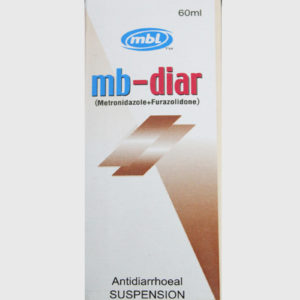
Each 5ml contains:
Metronidazale Benzoate
e.q. to Metronidazole B.P…100mg
Futrazolidone B.P ….50mg
It is recommended for the treatment of dysentery of protozoal, bacterial or mixed origin; amoebiasis (intestinal and extra intestinal disease, and that of symptomless cystpassers): bacillary dysentery, giardiasis and food poisoning caused by the many susceptible strains and species of gram species of gram-positive and gram-negative bacteria.
4 x5 ml 3 times daily
(1-5Years) 1x5ml 3 times daily
(Over 5 Years) 2x5ml 3 times daily